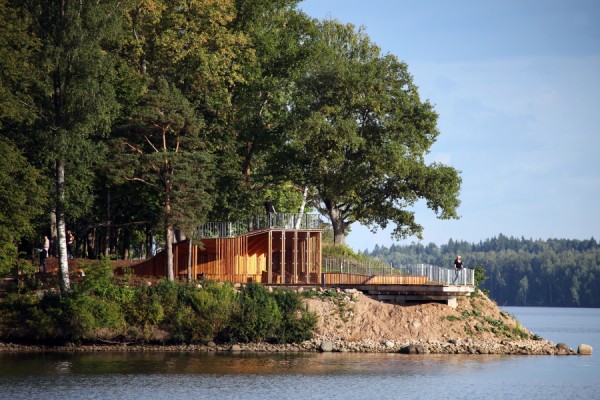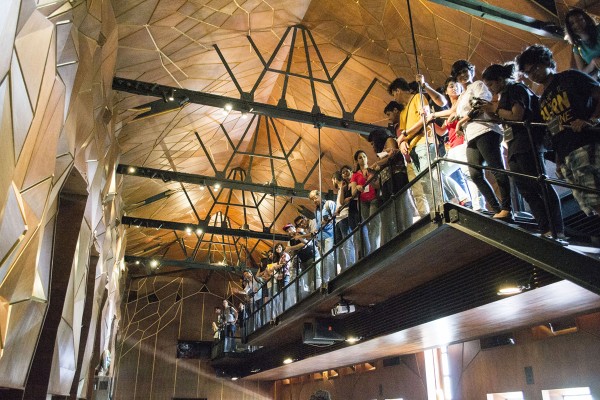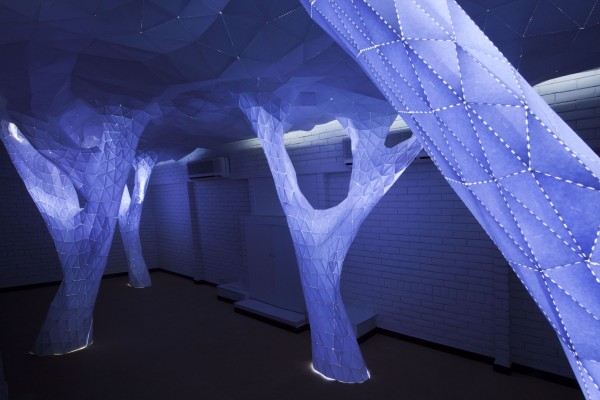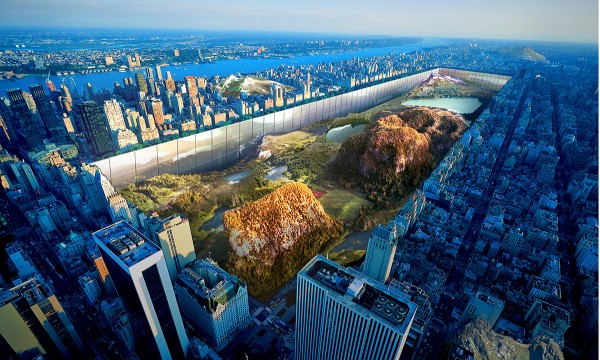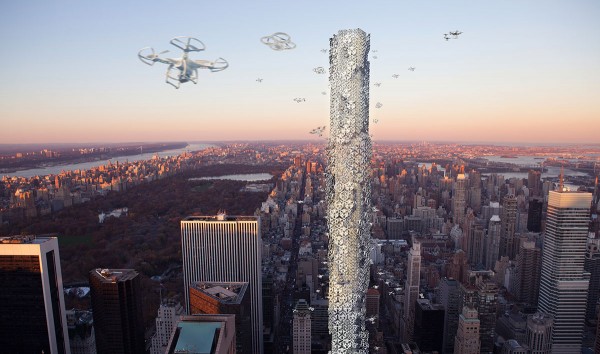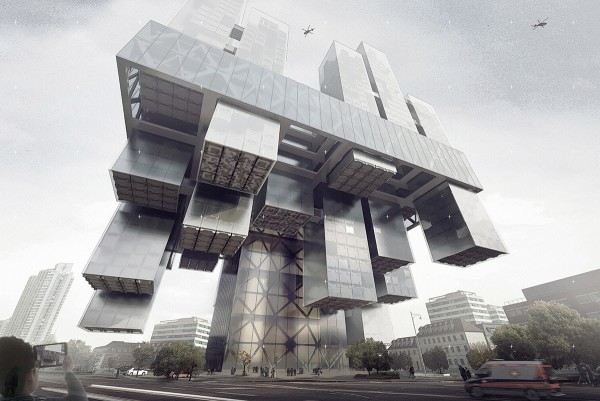View Terrace and Pavilion designed by Didzis Jaunzems, Laura Laudere in collaboration with architecture office Jaunromans & Abele are situated in memorial park “The Garden of Destiny”, the area of Consolation, Latvia which is the first zone of Future according to overall project of the island. The Garden of destiny is memorial place for all souls that have been lost to Latvia in last century and it will be completed as a gift to country on its 100th birthday in year 2018. The View Terrace project started as an architectural competition and with a help of donations is now first realized permanent building in memorial park. The tight bound between Latvian people and nature has been emphasized in the project. Nature is a source of inner energy, strength, peace and harmony and consolation for Latvians. The project has been designed considering and using sights particularities – trees, relief, most stunning view points. Viewing terrace and building has diversified levels of “openness”. This gives the opportunity to use the building in all kinds of weather conditions as well as lets visitors to choose the level which suits them better. The volume of the pavilion is designed so that it gradually grows from a bench into the building. Read the rest of this entry »
Wood View Terrace And Pavilion In An Isolated Island In Latvia
Precise Inaccuracy: ArchitectScripta Maya-Grasshopper Workshops July 2016 in Athens, Greece
ArchitectScripta is organizing two Workshops in July 2016 in Athens, Greece taught by Nefeli Chatzimina [Lecturer at the University of Southern California,PhD Candidate NTUA] and Justin Brecthel [Adjunct Lecturer at University of Southern California,UCLA,LEED], both Alumni Graduates of Columbia University NYC [GSAPP, AAD], with Nikos Papavasileiou [ArchitectScripta Project Architect]. ArchitectScripta Workshops refer to Students of Architecture and Art, Professional Architects, Designers and Artists.
1) Workshop I from 27th of June until the 7th of July 2016 Workshop I, hosted by the Benaki Museum, under the auspices of the Hellenic Institute of Architecture and the Athens School of Fine Arts.
2) Workshop II from 11th of July until the 21st of July 2016 Workshop II, hosted by the Benaki Museum, under the auspices of the Hellenic Institute of Architecture and the Athens School of Fine Arts.
More information could be found here
Registration is OPEN now by email
Please connect with us in Facebook
BioMorph 2016: AA Visiting School India
The Biological Morphologies workshop is focused on material efficiency in nature and how this can be the inspiration for innovative structural solutions. This will be a digital craft workshop that considers the forming of structures inspired by biology and realised through a feedback to computational platforms, specifically using the material Bamboo.
Over the duration of the workshop the students will work in teams to develop projects that are directly derived from biological logic, whilst at the same time help construct a bamboo pavilion at the BNCA College in Pune. The deadline for applications is 2nd July 2016.
Forest-Like Installation Designed By A Series Of Algorithms That Generate Venation Patterns
Orproject developed a series of algorithms that digitally generate open and closed venation patterns, which can be used to simulate the growth of topiaries. The systems consist of a set of seed points that grow and branch towards target points in order to maximize exposure to light for each leaf. The resulting geometries fulfill these requirements and provide a suitable structural and circulatory system for the plant.
The structural system of topiaries acts mainly in compression and bending. Reversing this, we can obtain a geometry that performs as a tensile system. The installation Vana is designed as a single surface in tension that hangs from the ceiling and descends into the space as four columns of light. The surface is tessellated into triangular segments which are connected by stitched joints. Back lit with LEDs, light shines through the gaps and illuminates the space below with an immersive glow.
As the prototype for a large scale canopy construction, Vana has been developed as an iso-surface around an anastomotic network diagram, as the cortex around the venation system. In a continuous transformation, nature merges into architecture, columns merge into the sky and solid merges into the ephemeral. Vana appears to grow as tree-like branches blending into a continuous canopy that floats above the visitor. The installation was designed for the India Design Forum. Read the rest of this entry »
Architectural Association Visiting School Hawaii: Flying Machines
The AA Visiting School Hawaii is the Architectural Association School of Architecture’s workshop dedicated to the investigation of flying machines.
Design, fabrication, geometry as well as performance and choreography will be the subject of our studies.
From their earliest use as measurement tools for the city, the 2000 year old history of flying machines is deeply rooted in architectural investigations. Gliding between its leisurely vocation and its scientific relevance, we will immerse into this legacy starting from the world’s oldest form of air-craft: the kite.
The participants will be organized in groups each responsible for the design and creation of one kite, intended as an abstract architectural machine, a modern scientific toolbox or a folly worth of a tropical Grand Tour.
In parallel to that we will be building a drone as a tool to record and document our efforts as well as to interact with our other air-crafts.
We will be testing and flying our air-crafts on the mountains and the beaches of Oahu Island as wells as the roofs of Honolulu, gearing up for our final take off, when all we’ll have built will collapse into one great play.
Website: hawaii.aaschool.ac.uk
AAVS Hawaii Dates: June 6 to 17, 2016
Registration Deadline: May 13, 2016
Director: Costantino Sambuy
Contact: Costantino.Sambuy@aaschool.ac.uk
Winners 2016 eVolo Skyscraper Competition
eVolo Magazine is pleased to announce the winners of the 2016 Skyscraper Competition. The Jury selected 3 winners and 21 honorable mentions from 489 projects received. The annual award established in 2006 recognizes visionary ideas for building high- projects that through the novel novel use of technology, materials, programs, aesthetics, and spatial organizations, challenge the way we understand vertical architecture and its relationship with the natural and built environments.
The FIRST PLACE was awarded to Yitan Sun and Jianshi Wu from the United States for the project New York Horizon. The design proposes a continuous horizontal skyscraper around the full perimeter of a sunken Central Park. The project would create 7 square miles (80 times greater than the Empire State Building) of housing with unobstructed views and connection to the park.
The Hive, designed by Hadeel Ayed Mohammad, Yifeng Zhao, and Chengda Zhu from the United States received the SECOND PLACE. The project imagines a vertical control terminal for advanced flying drones that will provide personal and commercial services to residents of New York City.
The recipients of the THIRD PLACE are Valeria Mercuri and Marco Merletti from Italy for the project Data Tower. The proposal envisions a sustainable skyscraper in Iceland designed for Internet servers.
Among the 21 honorable mentions there are skyscrapers that purify air, buildings conceived to create rain for the driest regions on Earth, vertical cities, sensory towers that explore our psychological relationship with space, and skyscrapers that prevent cities to sink.
The members of the Jury are: Matias del Campo [principal SPAN], Thom Faulders [principal Faulders Studio], and Marcelo Spina [principal PATTERNS].
The 2016 Skyscraper Competition was made possible with the sponsorship of our media partners and v2com.
eVolo Magazine is also pleased to announce the publication of EVOLO SKYSCRAPERS 3, the third book in the Skyscraper Series. This publication includes the best 150 projects received in the 2014, 2015, and 2016 competitions. This is a limited edition book and only 500 copies will be available worldwide.
New York Horizon
First Place
2016 Skyscraper Competition
Yitan Sun, Jianshi Wu
United States
As the busiest and most densely populated county in America, Manhattan has always been a big fan of skyscrapers. Limited by its street grid, however, buildings in New York City are often skinny and tall. Rather than constructing another slim tower by building upwards, “New York Horizon” envisions a new paradigm by digging downward to Central Park’s bedrock, which will reveal the park’s rugged natural terrain while also creating a continuous wall of skyscrapers around its periphery to house habitable spaces with unobstructed views of the new underground park.
Envisioned by Frederick Law Olmsted and Calvert Vaux over 150 years ago, Central Park was so beautifully designed that the people of today overlook the fact that it is actually an artificial piece of land built upon the once rugged, bedrock-strewn landscape, which had to be heavily sculpted in order to show any semblance to a park. The project’s inspiration builds upon Olmsted’s theory of providing equally accessible common green space to all citizens and giving people “greater enjoyment of scenery than they could otherwise have consistently with convenience within a given space”. His vision, however, is slowly disappearing as skyscrapers continue to rise higher than ever around the park. And unfortunately, only the affluent few that can live and/or work on top of these towering skyscrapers are given the benefit and enjoyment of the park’s total stunning view on a daily basis.
The project was conceived to contrast against the city’s densely constructed buildings and towering skyscrapers, as well as, to provide New Yorkers with a natural environment that they could enjoy and use as an escape from their busy urban lives. Consequently, the soil removed from the park would be used to add a more dynamic landscape (mini-mountains, hills etc.) to underdeveloped plots all over Manhattan. This would create a new urban condition, where the newly constructed landscape becomes a cohesive part of the city.
This reimagined parkland would allow for hiking, climbing, swimming and other outdoor activities. And finally, the reflective glass façade canvassing the wall of skyscrapers will reflect the park’s natural terrain and create the illusion of a never-ending natural world within the heart of Manhattan’s concrete jungle, while also offering New Yorkers’ a perspective of the landscape that is not limited by the park’s physical boundaries.
The 1000 feet tall, 100 feet wide wall of skyscrapers/mega-structure would create 7 square miles (80 times greater than the Empire State Building) of habitable indoor space, while introducing more natural diversity and verticality to the once flat 1.3 square mile Central Park. The seven-mile-perimeter wraparound mega-structure would contain apartments, retails, museums, libraries, etc. within the 100 feet deep inhabitable walls, with an unobstructed view and connection to the park. Following Manhattan’s city grid, there are main circulation cores (elevators) that would align with every single street from 59th to 110th street to transfer people down to the park, as well as to other various floors. Secondary circulation (ramps, stairs) would connect separate spaces in various scales between the cores.
The goal of the concept is to reverse the traditional relationship between landscape and architecture. Instead of building distant, flat landscapes to surround and complement individual architectural buildings, the natural landscape is now the centerpiece. In this case, the dynamic landscape is surrounded by characterless architecture that tries to be nothing but mirror that reflects nature.
In the heart of New York City’s concrete jungle, a New Horizon is born.
The Hive: Drone Skyscraper
Second Place
2016 Skyscraper Competition
Hadeel Ayed Mohammad, Yifeng Zhao, Chengda Zhu
United States
Drone technology, adopted by many large corporations, has become a leading trend in the field of fast-delivery, aerial mapping, commercial advertising, government inspection, and filmmaking. As recent years have witnessed a rise in the development of drone technology, several major corporations, such as Amazon, DHL and Walmart, have begun investigating the use of drones in high-speed delivery service. As more and more people live on internet-based lifestyles, these “small flying robots” could easily become an ordinary part of future everyday life. The demand for high-speed drone delivery is estimated to increase continuously in the upcoming years. However, legal restrictions on the navigation of drones are currently standing in the way of drastically broadening the use of drones in various aspects of our daily lives. No-fly zones and conditions to maintain visibility with the drone at all times are two of the main constraints.
The Hive is an infrastructure project that can better meet the emerging demand for incorporating advanced Drone technology into daily life in New York City. The project was proposed as an alternative asset argument for the usage of the land on 432 Park Avenue, the project aims to create a central control terminal that hosts docking and charging stations for personal or commercial drones (unmanned aerial vehicles) in the center of Manhattan. The current air-zoning regulations are to be re-shaped in a vertical highway model around a tower. This centrally controlled model will be more appealing to the legislative sector as it adheres to the concerns about regulating drone traffic. The primary location of the building does not only gather the commercial power of Manhattan, but also stands away from the no-fly-zones set by the FAA.
Live Façade
The Modules on the façade are designed to fit nine different types of drones, categorized by the shape and scale of their landing fixtures (point, bar or ring). A sequential study of how to categorize non-uniformed industry products into modular fixed architectural structures was conducted through a series of simplification of the geometries and articulations of the forms. The different sizes and geometry of the drone paired with different size and geometry of the module result in a variety of configurations.
To provide a safe landing environment, the tower projected a new method for drones to dock horizontally onto their corresponding platforms with the fitting shape and scale; the platform with docked drones can be flipped vertically to be in parallel with the tower façade. The façade is constantly animated as the platforms flip outwards and backwards to nest back into it.
The overall organization of the façade uses layering as means to maximize surface area, with two overlapping exterior layers and an inner layer. A hierarchy is established, as the size of drones and modules is smaller in the inner layer creating a more intricate interior that can be accessed by the smallest drones by a major opening in the façade.
The transparency of the tower changes constantly, while the tenants of the building-the drones fly in and out. The flickering lights of the battery station behind each module help with navigation and also indicate the occupancy percentage of the building as well. Read the rest of this entry »
Data Skyscraper: Sustainable Data Center In Iceland
Third Place
2016 Skyscraper Competition
Valeria Mercuri, Marco Merletti
Italy
Data is proliferating: every transaction, entry, emails, and even every mouse click is stored in a server. Annual global IP traffic will pass the zettabyte threshold by the end of 2016, and will reach 2 zettabytes per year by 2019. Considering this, a problem in the near future will be to find a place to store this information.
A data center is the physical location hosting different servers used by many types of companies, it is used to store and process all the information we generate every day.
Today data centers consume a lot of energy and have a large carbon footprint: servers absorb a lot of electrical power and they need to be constantly cooled down to avoid overheating problems.
The solution for the future is hosting data centers where the power is clean and the costs are low. For this reason some companies have been started to think about Iceland. Iceland is a strategic location for data centers for 3 reasons:
• Location: its placement between Europe and the U.S. means that companies can run their web services for both continents in one location;
• Renewable energy sources: Iceland can offer data center services powered by 100% clean energy (hydropower and geothermal) for the same price or less than web services powered by fossil fuel-based grids in other locations;
• Climate: Iceland’s proximity to the Arctic Circle allows exploiting cold temperatures and a fresh natural breeze that could be used to cool down the servers avoiding the costs of a traditional cooling system.
Our project is a vision of how could it be a future green data center located in Iceland. A data center is often a large industrial building without a significant architectural connotation, a big anonymous container. The main issue of our project is to investigate a new morphological solution that could represent both the complexity and the importance of the building into which we keep our data. Above all, we conceive the data center’s configuration in order to maximize the use of the available renewable energies and also to allow the re-use in a sustainable way.
The tower is conceived as a giant 3D motherboard with a cylindrical shape. On the external façade are fastened all the hardware components, otherwise the internal part is empty. This void is a technical space with a double function: first, it is the main air duct of the cooling system, and second it is a space where the pods can be moved to the ground floor, during the maintenance and the upgrade phases. As well as in a computer case, a huge cooling fan on the top of the tower activates a natural chimney effect, thanks to which each pod takes the natural fresh air from outside and releases the warm air inside. A part of this air is expelled from the top of the tower, another part is re-used to heat the laboratories and the greenhouses situated in the basement. During the winter the warm air released by the server could be also used to heat the houses in the surrounding neighborhood.
The modern data center is a particular building in continuous evolution: as well as in a motherboard, where the components are always replaced and updated, also the façade of the tower is adaptable and in continuous evolution; in fact, depending on necessity, the density and the position of the pods can freely change increasing the height of the tower. Read the rest of this entry »
Trans-Pital: Space Adaptive Skyscraper Hospital
Honorable Mention
2016 Skyscraper Competition
Chen Linag, Jia Tongyu, Sun Bo, Wang Qun, Zhang Kai, Choi Minhye
China
The medical and health organization of a country includes the country’s security and improves the health of the people, the treatment of diseases and injuries of persons, organizations, systems and processes. The hospital plays a very important role in the system. However, the world is generally encountered in the case of lack of hospitals to serve the patients, at the same time, the chaos of the hospital streamline is not convenient for patients to use.
A space and tectonic responsive hospital is easy to assemble and reflects the society. It shows the BMI from the morphology of itself. Morphological changes can be suitable for various terrain environments, at the same time according to the functional requirements to change in morphology.
The medical building tries to solve the medical problems, so that the building can reflect the urban living conditions of the urban human settlements directly. The building collected within 10 km radius of the residents’ health data, which is reflected from the building surfaces directly, and the internal function (inpatient, emergency treatment, medical technology, and the outpatient which contains 50 departments) consistently.
Patients arrive at the hospital, and enter the core tube directly to the emergency treatment and the outpatient departments directly. The patients who need the in-patient treatment will transfer to the wards. The idea of the hospital is that the patient does not have to move by himself, according to the motion track, the wards can move to where it should go to, like the outpatient space for further consultation with a doctor instead. However, if there are not too many patients of any department, the space for the outpatient and in-patient will be folded to form a therapy garden space.
The whole building is divided into a frame, a core tube structure, a large assembled body, which is an independent department module, and a small mobile body which is a medical cubic module inside the large assembled body.
Technology
The small medical cubic module could move on the track in and among the large assembled bodies to form the body of the independent department.
Driving device
It is the mechanism that drives the actuator to move, according to the command signal sent by the control system, the module moves with the aid of the power element. It is the input of the electrical signal, the output of the line and the angular displacement.
Detecting device
It is a real-time detection of movement and work, according to the need to feed back to the control system, and sets the information after the comparison, the implementation of the organization to adjust, to ensure that the action is in accordance with the requirements of the scheduled.
Control system
One is centralized control, which is the total mechanical control by a microcomputer to complete. The other is decentralized (level) control, which uses multiple computers to share the control. Read the rest of this entry »

